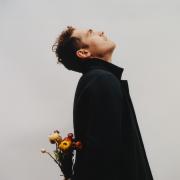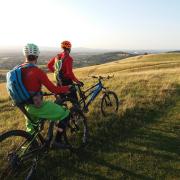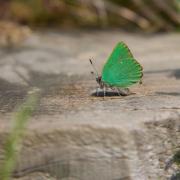Gallery Pangolin’s first-of-its-kind exhibition takes world-class contemporary sculpture to the depths of the Forest of Dean’s ancient caves
A visit to Gloucester Cathedral eight years ago became the catalyst for something rather extraordinary happening this month in the depths of the Forest of Dean.
Heather and John Wright, owners of Clearwell Caves, near Coleford, visited Pangolin Gallery’s remarkable ‘Crucible 2’ exhibition at the Cathedral – featuring sculpture by such greats of the art world as Lynn Chadwick, Antony Gormley, Eilis O’Connell and Terence Coventry – and wondered whether it would be possible to stage something similar up to 200 feet underground in their ancient mines.
%image(15709870, type="article-full", alt="'Aftermath I' and 'Aftermath II', by Steve Hurst. Bronze, 2004")
‘It was going to Crucible 2 all those years ago,’ says Heather, speaking in the Gloucestershire sunshine before we make our descent, ‘that made me think the caves would really lend themselves to an exhibition of this type. Then, three years ago, I decided to approach Pangolin, thinking they’d say “no” – but I obviously contacted the right people.’
The collaboration turned out to be something far greater, more profound – and more challenging – than any of them could imagine.
Pangolin Editions was founded in 1985 by husband-and-wife team Rungwe Kingdon and Claude Koenig in a ramshackle greenhouse in Oxfordshire, before moving to far larger premises in the valley at Chalford, where they now cast and fabricate sculptural pieces for many of the foremost sculptors of our time.
%image(15709871, type="article-full", alt="'Mitochondrial Eve', by Sue Freeborough. Bronze, 2011. In the background, to the left, can be seen Geoffrey Dashwood's Barn Owl, 1994")
‘Of course, Pangolin isn’t just a foundry,’ says Rungwe, donned in overalls, freshly kissed by ochre from the caves, ‘it’s a sculpture organisation, and so putting on exhibitions is just as much a part of our remit. We did some research, and we found that no-one has done an exhibition in a cave since prehistoric times. It’s where art starts. When Heather approached us, it seemed like such an amazing opportunity – here’s a couple who actually own a cave and are asking us to put on an exhibition there, allowing us to put together a series of works that create dialogue with the caves.
‘We’ve managed to find all sorts of relevancies, whether it’s the materials that things are made of, or how it echoes with the history of caves in general... or indeed this one in particular.’
Putting on an exhibition of a singular artist’s work in the conventional setting of a white-walled gallery can be challenging enough, but where does one start with bringing together 47 international artists, persuading them to display their art deep underground, and then getting it there – and back out – safely?
‘It’s a bit of a double act,’ continues Claude, in her rich French accent. ‘Rungwe tends to choose the pieces, and I’ll find a resonance with the environment where it fits best. You see the location several times and you try to connect with it. At the Cathedral it was a slightly easier task; there are several centuries of art, all there, talking back at you. Here, you have to let other things influence it... the ‘what might have been’.
‘You know how you see images in clouds,’ she continues, ‘when you look at the cave for long enough you see all sorts of things – triggering images of animals, or faces.’
%image(15709872, type="article-full", alt="'Spike' is one of David Mach's classic 'Coathanger' pieces")
The street artist Stik is painting a site-specific piece – actually directly onto the wall of the cave – using the naturally-occurring ochres extracted from the ground. So, it’s both on the cave and of the cave. He’s responding to the cave as he works, and though I don’t see the artist at work, I get a glimpse of the work in progress when I visit, and it already has the feel of being ancient, perhaps created by a Palaeolithic artist by flickering candle light, using art supplies gifted by Mother Earth Herself.
‘The similarities between street art and the original Palaeolithic art are considerable,’ says Rungwe. ‘Street artists tend to use spray paint, and a lot of the Palaeolithic paintings were done by a technique of spraying pigment through a tube onto the walls of these caves. They were responding to the cave, and here we have Stik doing exactly the same thing, but with all the experience of living in the 21st-century. When you ask most street artists whether they’ve painted underground, they’ll think of the Circle Line. Underground here has a different meaning, and I think that’s something very enjoyable to play with; art uses metaphor an awful lot, and here in the caves we have so many metaphors, that we can actually reinterpret even familiar sculptures in a new way, because of the environment.’
READ MORE: Why you should visit the Forest of Dean this summer.
Heather’s husband John, who inherited the caves from his father Ray Wright, still removes small amounts of ochre from the caves by hand – as his father did – using just a simple pick axe, spoon and lots of patience. These are sold in the shop and supply artists to this day.
On first entering the caves, one of the permanent displays is of a series of votive heads, created of clay and covered in ochre. The heads had been recovered from a well there, which begins our journey into man’s long association with the space; we don’t know why the heads were created or indeed why they were cast into the well.
%image(15709873, type="article-full", alt="'Dagon', by Abigail Fallis: 'This strange fish is believed to have come from the Ark of God. Records show that Dagon, a half fish/ half man deity was worshipped as far back as the Philistines and Babylonians, and was visually depicted in painting and sculpture in Nineveh Assyria.' In the background can be seen a 1960s addition to the cave, believed to have been painted by playful students")
Many of the sculptures that have been brought in as part of the ‘Back to the Cave’ exhibition have more obvious references to the caves: Eduardo Paolozzi’s plaster maquette for ‘London - Paris’ shows the fragmented pieces of one of his colossal ‘Vulcan’ sculptures being transported by railway wagon, echoing the tracks that descend deep into the caves from the time when they were worked by miners.
Other pieces reference the bat population in the caves – both lesser and greater horseshoe bats have a protected environment here – and Nick Bibby’s ‘Lesser Mascarene Fruit Bat’ finds it natural home, protected within a limestone alcove. There’s also a clever piece by Mat Collishaw – ‘Echolocation’ – that uses augmented reality to create an interactive piece using our own mobile phones. ‘Our phones employ gyroscopes and geolocation functions which track every nuanced movement we make,’ he says. ‘This augmented reality bat attempts to illustrate the quasi-mystical dimensions new technologies give us access to.’
%image(15709874, type="article-full", alt="'Lesser Mascarene Fruit Bat', by Nick Bibby. Bronze, 2004")
%image(15709877, type="article-full", alt="'Lion' (1960), and 'Beast IX' (1956), both by Lynn Chadwick")
It’s true that underground spaces resonate with us in a way that no other places do. As Robert MacFarlane writes in his book, Underland: ‘I have rarely felt as far from the human realm as when only 10 metres below it, held in the shining jaws of a limestone bedding plane first formed on the floor of a warm Cretaceous sea.’
And Rungwe would tend to agree.
‘We’re drawn to spaces that we feel are special,’ he says, ‘and it’s very easy for a cave to feel special; because of the darkness, you have to rely on other senses... there are animals you don’t normally see, and they’re also the place where art starts. For us, our whole imaginative journey of culture starts in caves, so it seems like a very potent environment. To have the opportunity to curate an exhibition in a space like that seems... well... it’s unique.
‘When I first saw the prehistoric caves [of Niaux and Altamira], the stories they created in my mind are the thing that I’m remembering, stimulated by the vision that was painted all those years ago. And so, hopefully, we can recapture a little bit of the way that objects can tell stories, because I think that’s what is really interesting.
%image(15709878, type="article-full", alt="'Brain', by Hans – Ulrich Pauly. Crystal, 2020. "In early 2018 out of the blue Uli Pauly had a stroke and had a scan of his brain which confirmed it. He sent us the scans and our digital team translated this 2D data into a 3D model of his brain."")
%image(15709879, type="article-full", alt="'Twixt Line and Form', by Peter Randall-Page")
‘The artists have responded fantastically,’ he continues, ‘all we invited have said “yes”, so we’ve had the pick of the pieces that make for a unique, beautiful and amazing experience. It’s so much more than an art exhibition; it helps create stories out of the pieces that then live on in your own imagination. That’s really what art is all about.’
As moving as the pieces are in their chosen setting deep underground, when above ground – away from the magic of being transported to the ‘other’ – it’s difficult to get away from thinking about the logistics of staging an exhibition such as this (although, of course, there never has been an exhibition ‘such as this’ before). The people that really make it possible are Rungwe and Claude’s trusty team from Pangolin who do all the logistics ‘back at the ranch’, but they admit that this has been a very different challenge. ‘They’ve really responded to where Claude wants to place the things,’ says Rungwe, ‘as they understand how placement is important; they know how to handle the art, but it is a challenge.’
%image(15709880, type="article-full", alt="'Willendorf Man', by Anthony Abrahams. Bronze, 1999")
%image(15709881, type="article-full", alt="'Skull', by Jonathan Kingdon. Bronze, 1963")
Claude confirms this, laughing, ‘Nothing is straight, nothing is flat, nothing is square... and then you bump your head on the wall!’
Teamwork genuinely is at the heart of all that Pangolin do.
‘Here we are,’ says Rungwe, ‘working as a team again, which is the whole point of what Pangolin is; it’s a whole team focused on art, and that’s the thing I love most about it. We can be a team to create things that we could never create on our own, but with the artist and with the team, we can create anything.’
Lighting is the final piece of the jigsaw; once all the sculptures have been placed where they should be, then lighting them well is an extremely important element, and so ambient lighting, spotlights and even candlelight all play their part.
As well as Stik’s site-specific ochre painting, another artist has created a piece as a direct response to Clearwell’s caves. Susie MacMurray’s ‘Mirage’ cascades as gossamer-fine silver-plated wire from the rock edge, using gravity to find its natural place in the cave.
%image(15709884, type="article-full", alt="'Mirage', by Susie MacMurray. Silver-plated copper wire, 2022. To the left is Susie's 2013 piece, 'Anaconda', created from handmade aluminium rings")
%image(15709885, type="article-full", alt="'Horse', by John Hoskin. Welded steel, 1957: “Welding is like knitting with fire.”")
‘When I visited Clearwell Caves,’ she says, ‘I was particularly struck by the spot where people have thrown coins into a pool of water. Instead of remaining pristine and glittering, they quickly become ossified by the minerals present, and are gradually absorbed back into the rock.’ This led her to think about the ritual practices of making offerings for good luck, wealth and health, and that ‘the glittering mirage of the pursuit of wealth, power over others, and permanence could seem a fool’s errand.’
With apologies for the pun, we’ve barely scratched the surface of this incredible exhibition with the space available here, and so you really must experience it yourself. Make the journey to the ancient forest, go beneath the surface of the earth, and experience ‘the other’.
%image(15709887, type="article-full", alt="'Longdog', by Jon Buck. Bronze, 2005")
‘We’ve got people in this exhibition,’ says Rungwe, ‘who make the monuments of our age; they actually articulate what it’s like to be alive now, and to put them into this environment – to create stories in our minds – seems like a fantastic opportunity. We’ve relished it.
‘Our foundry work creates a nice link with Clearwell,’ he concludes, ‘this is where all that metal was scratched out of the ground, and here’s some of it coming back in different ways. There is a sense of honouring the sheer graft of the people who went underground and dug all this stuff out. Much of the machinery that was used is slowly going back into the earth... it’s a nice cycle.’
Back to the Cave is at Clearwell Caves in the Forest of Dean (GL16 8JR) until August 29. For more information and to book tickets visit gallery-pangolin.com and clearwellcaves.com
%image(15709889, type="article-full", alt="'Boar II', by Terence Coventry. Bronze, 1999")




























